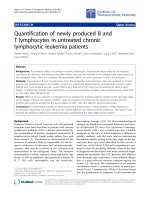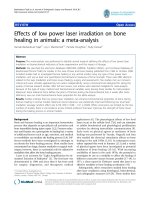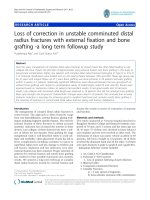Báo cáo hóa học: " Existence of positive solutions to periodic boundary value problems with sign-changing Green’s function" ppt
Bạn đang xem bản rút gọn của tài liệu. Xem và tải ngay bản đầy đủ của tài liệu tại đây (202.79 KB, 6 trang )
RESEA R C H Open Access
Existence of positive solutions to periodic
boundary value problems with sign-changing
Green’s function
Shengren Zhong
1
and Yukun An
2*
* Correspondence: anykna@nuaa.
edu.cn
2
Department of Mathematics,
Nanjing University of Aeronautics
and Astronautics Nanjing, 210016,
PR China
Full list of author information is
available at the end of the article
Abstract
This paper deals with the periodic boundary value problems
u
+ ρ
2
u = f(u), 0 < t < T
,
u(0) = u(T), u
(0) = u
(T),
where
0 <ρ≤
3π
2T
is a constant and in which case the associated Green’s function
may changes sign. The existence result of positive solutions is established by using
the fixed point index theory of cone mapping.
Keywords: periodic boundary value problem, positive solution, sign-changing
Green’s function, cone, fixed point theorem
1 Introduction
The periodic boundary value problems
u
+ a(t) u = f (t , u), 0 < t < T
,
u(0) = u(T), u
(0) = u
(T),
(1)
where f is a continuous or L
1
-Caratheodorytypefunctionhavebeenextensively
studied. A very popular technique to obtain the existence and multiplicity of positive
solutions to the problem is Krasnosel’skii’ s fixed point theorem of cone expansion/
compression type, see for example [1-4], and the references contained therein. In those
papers, the following condition is an essential assumptions:
(A) The Green function G(t, s) associated with problem (1) is positive for all (t, s) Î
[0, T] × [0, T].
Under condition (A), Torres get in [4] some existence results for (1) with jumping
nonlinearities as well as (1) with a repulsive or attractive singularity, and the authors in
[3] obtained the multiplicity results to (1) when f(t, u) has a repulsive singularity near x
=0andf(t, u) is super-linear near x =+∞.In[2],aspecialcase,a(t) ≡ m
2
and
m ∈ (0,
π
T
)
, was considered, the multiplicity results to (1) are obtained when the non-
linear term f(t, u) is singular at u = 0 and is super-linear at u = ∞.
Recently, in [5], the hypothesis (A) is weakened as
(B)TheGreenfunctionG(t, s) associated with problem (1) is nonnegative for all
(t, s) Î [0, T] × [0, T] but vanish at some interior points.
Zhong and An Boundary Value Problems 2011, 2011:8
/>© 2011 Zhong and An; licensee Spri nger . This is an Open Acce ss article distribute d under the terms of the Creative Commons
Attribution License ( which permits unrestricted use, distribution, and reproduction in
any medium, provided the original work is properly cited.
By defining a new cone, in order to apply Krasnosel’skii’sfixedpointtheorem,the
authors get an existence result when
f
(
t, u
)
= g
(
t
)
¯
f
(
u
)
and
¯
f
(
u
)
is sub-linear at u =0
and u = ∞ or
¯
f
(
u
)
is super-linear at u =0andu = ∞ with
¯
f
(
u
)
is convex and
nondecreasing.
In [6], the author improve the result of [5] and prove the existence results of at least
two positive solutions under conditions weaker than sub- and super-linearity.
In [7], the author study (1) with f(t, u)=lb(t)f(u) under the following condition:
(C) The Green function G(t, s) associated with problem (1) changes sign
and
min
t∈[0,T]
T
0
G
−
(t , s)ds = m
∗
>
0
where G
-
is the negative part of G.
Inspired by those papers, here we study the problem:
u
+ ρ
2
u = f(u), 0 < t < T
,
u(0) = u(T), u
(0) = u
(T),
(2)
where
0 <ρ≤
3
π
2T
is a constant and the associated Green’s function may changes
sign. The aim is to prove the existence of positive solutions to the problem.
2 Preliminaries
Consider the periodic boundary value problem
u
+ ρ
2
u = e(t), 0 < t < T
,
u(0) = u(T), u
(0) = u
(T),
(3)
where
0 <ρ≤
3π
2T
and e(t) is a continuous function on [0, T]. It is well known that
the solutions of (3) can be expressed in the following forms
u
(t )=
T
0
G(t , s)e(s)ds
,
where G( t, s) is Green’s function associated to (3) and it can be explicitly expressed
G(t , s)=
sin ρ
(
t−s
)
+sin ρ
(
T−t+s
)
2ρ(1−cos ρT)
,0≤ s ≤ t ≤ T
,
sin ρ(s−t)+sin ρ(T−s+t)
2ρ
(
1−cos ρT
)
,0≤ t ≤ s ≤ T
.
By direct computation, we get
sin ρT
2ρ
(
1 − cos ρT
)
≤ G( t, s) ≤
sin
ρT
2
ρ
(
1 − cos ρT
)
=max
t,s∈[0,T ]
G(t , s)
,
and
G
(
t, s
)
<
0
for
|
t − s| <
T
2
−
π
2
ρ
when
π
T
≤ ρ ≤
3π
2T
, and
g(t)=
T
0
G(t , s)ds =
1
ρ
2
, t ∈ [0, T]
,
min
t∈[0,T]
T
0
G
+
(t , s)ds
T
0
G
−
(t , s)ds
=
1
1 − sin
ρT
2
,
where G
+
and G
-
are the positive and negative parts of G.
Zhong and An Boundary Value Problems 2011, 2011:8
/>Page 2 of 6
We denote
σ =
1
ρ
2
max
t,s∈
[
0,T
]
G(t , s)
=
2sin
ρT
2
ρ
,
and
γ =
+∞,0≤ ρ ≤
π
T
,
1
1−sin
ρT
2
,
π
T
<ρ≤
3π
2T
.
Let E denote the Banach space C[0, T] with the norm ||u|| = max
tÎ[0,T]
|u(t)|.
Define the cone K in E by
K = {u ∈ E : u ≥ 0,
T
0
u(s)ds ≥ σ ||u||}
.
We know that
σ =
sin
ρT
2
ρ
2
<
T
and therefore K ≠ ∅. For r>0, let K
r
={u Î K :||u|| <
r}, and ∂K
r
={u Î K :||u|| = r}, which is the relative boundary of K
r
in K.
To prove our result, we need the following fixed point index theorem of cone
mapping.
Lemma 1 (Guo and Lakshmikantham [8]). Let E b e a Banach space and let K ⊂ E
be a closed convex cone in E. Let L : K ® K be a completely continuou s operator and
let i(L, K
r
, K) denote the fixed point index of operator L.
(i)IfμLu ≠ u for any u Î ∂K
r
and 0 < μ ≤ 1, then
i
(
L, K
r
, K
)
=1
.
(ii)If
inf
u∈∂K
r
||Lu|| >
0
and μLu ≠ u for any u Î ∂K
r
and μ ≥ 1, then
i
(
L, K
r
, K
)
=0
.
3 Existence result
We make the following assumptions: (H1) f : [0, +∞) ® [0, +∞) is continuous;
(H2) 0 ≤ m = inf
uÎ[0,+ ∞]
f (u) and M = sup
uÎ[0,+ ∞)
f (u) ≤ +∞;
(H3)
M
m
≤
γ
, when m = 0 we define
M
m
=+
∞
.
To be convenience, we introduce the notations:
f
0
= lim
u→0
f
(u)
u
and f
∞
= lim
u→∞
f
(u)
u
,
and suppose that f
0
, f
∞
Î [0, ∞].
Define a mapping L : K ® E by
Lu(t )=
T
0
G(t , s)f (u(s))ds, t ∈ [0, T]
.
It can be easily verified that u Î K is a fixed point of L if and only if u is a positive
solution of (2).
Lemma 2.Supposethat(H
1
), (H
2
)and(H
3
)hold,thenL : E ® E is completely
continuous and L(K) ⊆ K.
Zhong and An Boundary Value Problems 2011, 2011:8
/>Page 3 of 6
Proof Let u Î K,thenincaseofg =+∞,sinceG(t, s) ≥ 0, we have Lu(t) ≥ 0on[0,
T]; in case of g <+∞, we have
Lu(t )=
T
0
G(t , s)f (u(s))ds
=
T
0
(G
+
(t , s) − G
−
(t , s))f (u(s))d
s
≥
T
0
(G
+
(t , s)m − G
−
(t , s)M)ds
= m
T
0
(G
+
(t , s) −
M
m
G
−
(t , s))ds
≥ m
T
0
(G
+
(t , s) − γ G
−
(t , s))ds
≥
0.
On the other hand,
T
0
Lu(t )dt =
T
0
T
0
G(t , s)f (u(s))dsdt
=
T
0
f (u(s))
T
0
G(t , s)dtd
s
≥
1
ρ
2
T
0
f (u(s))ds.
and
Lu(t )=
T
0
G(t , s)f (u(s))ds ≤ max
t,s∈[0,T]
G(t , s)
T
0
f (u(s))d
s
for t Î [0, T]. Thus,
T
0
Lu(t )dt ≥ σ max
t∈[0,T]
|Lu(t)|
,
i.e., L(K) ⊆ K. A standard argument can be used to show that L : E ® E is comple-
tely continuous.
Now we give and prove our existence theorem:
Theorem 3. Assume that (H
1
), (H
2
) and (H
3
) hold. Furthermore, suppose that f
0
> r
2
and f
∞
< r
2
in case of g =+∞. Then problem (2) has at least one positive solution.
Proof Since f
0
> r
2
, there exist ε > 0 and ξ >0 such that
f
(
u
)
≥
(
ρ
2
+ ε
)
u,forallu ∈ [0, ξ ]
.
(4)
Let r Î (0, ξ), then for every u Î ∂K
r
, we have
T||Lu|| ≥
T
0
Lu(t )dt
=
T
0
f (u(s))
T
0
G(t , s)dtd
s
≥
1
ρ
2
T
0
f (u(s))ds
≥
ρ
2
+ ε
ρ
2
T
0
u(s)ds
≥
(ρ
2
+ ε)σ r
ρ
2
> 0.
Zhong and An Boundary Value Problems 2011, 2011:8
/>Page 4 of 6
Hence,
inf
u∈∂K
r
||Lu|| >
0
. Next, we show that μLu ≠ u for any u Î ∂K
r
and μ ≥ 1.
In fact, if there exist u
0
Î ∂K
r
and μ
0
≥ 1 such that μ
0
Lu
0
= u
0
, then u
0
(t) satisfies
u
0
(t )+ρ
2
u
0
(t )=μ
0
f (u
0
(t )), 0 < t < T
,
u
0
(0) = u
0
(T), u
0
(0) = u
0
(T).
(5)
Integrating the first equation in (5) from 0 to T and using the periodicity of u
0
(t) and
(4), we have
ρ
2
T
0
u
0
(t ))dt = μ
0
T
0
f (u
0
(t ))ds
≥ ( ρ
2
+ ε)
T
0
u
0
(t )dt
.
Since
T
0
u
0
(t ))dt ≥ σ ||u
0
|| >
0
,weseethatr
2
≥ (r
2
+ ε), which is a contradiction.
Hence, by Lemma 1, we have
i
(
L,K
r
,K
)
=0
.
(6)
On the other hand, since f
∞
< r
2
, there exist ε Î (0, r
2
) and ζ >0 such that
f
(
u
)
≤
(
ρ
2
− ε
)
u,forallu ≥ ζ
.
Set C = max
0≤u≤ζ
|f (u)-(r
2
- ε)u| + 1, it is clear that
f
(
u
)
≤
(
ρ
2
− ε
)
u + C,forallu ≥ 0
.
(7)
If there exist u
0
Î K and 0 < μ
0
≤ 1 such that μ
0
Lu
0
= u
0
, then (5) is valid.
Integrating again the first equation in (5) from 0 to T, and from (7), we have
ρ
2
T
0
u
0
(t ))dt = μ
0
T
0
f (u(t))dt
≤ ( ρ
2
− ε)
T
0
u
0
(t )dt + C
.
Therefore, we obtain that
C
ε
≥
T
0
u
0
(t )dt ≥ σ ||u
0
||
,
i.e.,
||u
0
|| ≤
C
σ
ε
.
(8)
Let
R > max{
C
σε
, ξ
}
,thenμLu ≠ u for any u Î ∂K
R
and 0 < μ ≤ 1. Therefore,
by Lemma 1, we get
i
(
L, K
R
, K
)
=1
.
(9)
From (6) and (9) it follows that
i
(
L, K
R
\
¯
K
r
, K
)
= i
(
L, K
R
, K
)
− i
(
L, K
r
, K
)
=1
.
Hence, L has a fixed point in
K
R
\
¯
K
r
, which is the positive solution of (2).
Zhong and An Boundary Value Problems 2011, 2011:8
/>Page 5 of 6
Remark 4. Theorem 3 contains t he partial results of [4-7] obtained in case of posi-
tive Green’s function, vanishing Green’s function and sign-changing Green’sfunction,
respectively.
4 An example
Let 0 ≠ q<1 be a constant, h be the function:
h(x)=
1, x ≥ 0,
0, x < 0
,
and let
f (u)=1+h(
π
T
− ρ)u
q
+(1− h(
π
T
− ρ))
2sin
ρT
2
π(1 − sin
ρT
2
)
arctan u
.
By the direct calculation, we get m = 1 and M = g, and f
0
= ∞ and f
∞
= 0 in case of g
=+∞. Consider the following problem
u
+ ρ
2
u = f(u), 0 < t < T
,
u(0) = u(T), u
(0) = u
(T),
(10)
where
0 <ρ≤
3π
2T
is a con stant. We know that the conditions of Theorem 3 hold for
the problem (10) and therefore, (10) have at least one positive solution from Theorem 3.
Acknowledgements
The authors are very grateful to the anonymous referee whose careful reading of the manuscript and valuable
comments enhanced presentation of the manuscript.
Author details
1
Department of Engineering Technology, Wuwei Occupational College Wuwei, 733000, Gansu, PR China
2
Department
of Mathematics, Nanjing University of Aeronautics and Astronautics Nanjing, 210016, PR China
Authors’ contributions
YA conceived of the study, and participated in its coordination. SZ drafted the manuscript. All authors read and
approved the final manuscript.
Competing interests
The authors declare that they have no competing interests.
Received: 27 January 2011 Accepted: 27 July 2011 Published: 27 July 2011
References
1. Graef, JR, Kong, L, Wang, H: Existence, multiplicity and dependence on a parameter for a periodic boundary value
problem. J Differ Equ. 245, 1185–1197 (2008). doi:10.1016/j.jde.2008.06.012
2. Jiang, D, Chu, J, O’Regan, D, Agarwal, RP: Multiple positive solutions to supperlinear periodic boundary value problem
with repulsive singular equations. J Math Anal Appl. 286, 563–576 (2003). doi:10.1016/S0022-247X(03)00493-1
3. Jiang, D, Chu, J, Zhang, M: Multiplicity of positive periodic solutions to supperlinear repulsive singular equations. J Differ
Equ. 210, 282–320 (2005)
4. Torres, PJ: Existence of one-signed periodic solutions of some second-order differential equations via a Krasnoselskii
fixed point theorem. J Differ Equ. 190, 643–662 (2003). doi:10.1016/S0022-0396(02)00152-3
5. Graef, JR, Kong, L, Wang, H: A periodic boundary value problem with vanishing Green’s function. Appl Math Lett. 21,
176–180 (2008). doi:10.1016/j.aml.2007.02.019
6. Webb, TRL: Boundary value problems with vanishing Green’s function. Commun Appl Anal. 13(4), 587–596 (2009)
7. Ma, R: Nonlinear periodic boundary value problems with sign-changing Green’s function. Nonlinear Anal. 74, 1714–1720
(2011). doi:10.1016/j.na.2010.10.043
8. Guo, D, Lakshmikantham, V: Nonlinear Problems in Abstract Cones. Academic Press, New York (1988)
doi:10.1186/1687-2770-2011-8
Cite this article as: Zhong and An: Existence of positive solutions to periodic boundary value problem s with
sign-changing Green’s function. Boundary Value Problems 2011 2011:8.
Zhong and An Boundary Value Problems 2011, 2011:8
/>Page 6 of 6









